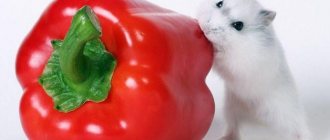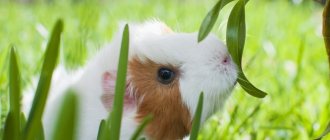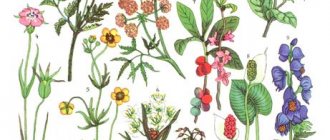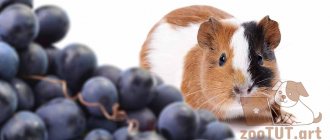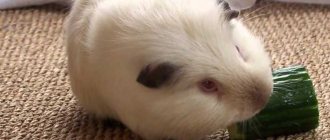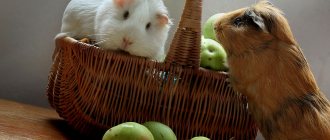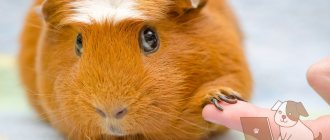Can guinea pigs eat bell pepper?
The body of guinea pigs is designed in such a way that for them there is no concept of the three traditional human meals (breakfast, lunch and dinner). In order for the intestines to fully process roughage, food must enter the digestive system almost constantly, but in very small portions. In their natural habitat (the South American mountains), these rodents consume large amounts of greens, which contain a lot of ascorbic acid, year-round.
Did you know? The ancestors of guinea pigs were significantly different from what these animals look like now: they were the size of an ox, and their weight was about 700 kg. They spread to European countries after Columbus discovered America.
Since the substance enters the body in sufficient quantities, the need for the ability to synthesize vitamin C has disappeared. Accordingly, tame guinea pigs also lack these processes, and at home, nutrition is much poorer than in the wild. Therefore, it is very important to constantly introduce foods containing vitamin C into this pet’s diet. Bell pepper is a vegetable high in ascorbic acid and carotene. It can and should be given to the animal, but in moderation.
Regular use of this product will help maintain your pet's circulatory system, strengthening the walls of small vessels. In addition, it will help strengthen the body's defenses and improve immunity. When compiling a diet for a guinea pig, you need to take into account all the physiological features of this animal and make it as balanced as possible. A deficiency or excess of any vitamin or mineral can negatively affect the health and well-being of your pet.
Important! The daily requirement of vitamin C for healthy individuals is about 10
–
30 mg. In sick, weakened, pregnant and lactating women, as well as young pets, the need increases.
Mango
Can hamsters eat mangoes? Mango is an exotic fruit containing many vitamins, sugars, carotenoids, and minerals. Mango is a controversial product for the diet of a furry pet. Foreign sources include this fruit in the list of permitted ones; some domestic sources also allow feeding small portions, while others believe that mango should absolutely not be given. We adhere to the latter opinion.
Why should you stop feeding your hamster this fruit?
- Mango is a strong allergen;
- Unripe fruits eaten in large quantities may cause indigestion or severe colic. How will you know what is the optimal amount of mango to give your hamster, because even the smallest piece can be too much for your pet;
- And from excessive consumption of ripe fruit, constipation or even fever can occur. Still, mango is a very difficult product for the digestive system.
Think and decide whether it is worth feeding your pet this fruit.
Also, some owners of small rodents are interested in whether hamsters can eat kiwi. Kiwi is an exotic fruit and contains a large amount of fruit acids, and can also cause an allergic reaction. And since allergies in a hamster are much more severe and not everyone recognizes them, you should not feed your pet foods that can trigger them. But still, on some foreign sites you can see kiwi in the list of allowed ones, which is very strange. After all, the potential harm of this product is much greater than the benefit.
How to give sweet peppers correctly
Feeding your guinea pig sweet peppers is easy. It does not require special processing or time-consuming preparations. A greenhouse product is unlikely to bring the desired benefits, so it should be given only during the season. During the period when pepper does not grow in the beds, it is recommended to replace it with a special balanced food containing all the vitamins and microelements in the required quantities.
In addition, you can consult a veterinarian regarding the advisability of taking vitamin C tablets, describing to him in as much detail as possible everything that your animal eats.
How to prepare a vegetable for feeding
Naturally, the pepper should be thoroughly washed before feeding it to the guinea pig. The washed vegetable is cleared of seeds and cut into small slices. It is also better to remove the thin film. Many pet owners often neglect this advice, but veterinarians strongly recommend giving bell peppers without the peel, since it is difficult to chew and can result in intestinal blockage.
Important! Green peppers contain solanine, which is dangerous for domesticated pigs. Animals should avoid eating this vegetable; they should also not be given hot peppers - this can harm their health.
How often and in what quantity can you give
Guinea pigs love fresh herbs and vegetables, including bell peppers. And, as a rule, as much as you put in their cage, they will eat as much. However, such overeating can cause serious harm to the health of this cute rodent. Therefore, treats should be given in doses. Bell pepper (100 g) contains 110 mg of ascorbic acid. Considering that other foods consumed by animals also contain vitamin C, but in smaller quantities, and the daily intake for a healthy animal should not exceed 16 milligrams per kilogram of weight, it is recommended to give no more than 25–30 g of pepper per day.
Contraindications
Excess vitamin C can lead to increased acidity, including in urine. This very often causes irritation and inflammation of the kidneys and urinary tract.
It is better to give fruit on days when there are no other sources of ascorbic acid on the menu.
It is contraindicated to give at the same time:
- with sour apples;
- with citrus fruits;
- with different types of cabbage.
If an animal has ulcers and redness on the mucous membranes of the lips and mouth, then kiwi is removed from the diet until they heal. In the case where the pig has manifestations of skin allergies, you need to check whether this is due to an excess of exotic fruit on the menu.
What else to include in a guinea pig's diet
A properly organized food regimen is very important for guinea pigs. A balanced and optimally selected diet is the key to good health, playfulness and a long life for pets.
Did you know? Guinea pigs are rightfully considered the most affectionate and sociable rodents. They are able to remember their name, and even distinguish colors, they love to be picked up and stroked, and if the animals are happy, they stretch or jump in place.
All products that are used as food for these rodents can be divided into the following categories:
- roughage (hay and twig food);
- succulent food (vegetables, berries and fruits). Healthy and permitted foods include carrots, cucumbers, celery, green leafy salads, pumpkin, zucchini, tomatoes, apples, raspberries, kiwis, cherries (pitted);
- green food (greens and herbs). It is strictly forbidden to feed guinea pigs with herbs collected near highways, fields that are treated with chemicals against pests, and in places where pets are walked. You can treat the animal with the leaves of the following plants: dandelion, plantain, yarrow, nettle, peas, oats, sweet clover, alfalfa, dill, sage, parsley, tarragon. Many of them are spicy or contain essential oils in large quantities, so it is better to give them in doses;
- concentrates (multicomponent high-calorie feeds).
There are foods that are strictly forbidden to give to guinea pigs. Some items on this list are quite obvious, while others may be surprising.
Do not neglect these recommendations - this can be fraught with serious consequences for your pet:
- dairy and meat products;
- sugar or any sweets;
- flour products;
- corn;
- onions and garlic (neither tops nor root vegetables);
- radish;
- cabbage;
- eggs;
- raw beets;
- potato;
- avocado;
- rocket and iceberg lettuce;
- nuts;
- rhubarb;
- beans and peas (green shoots are ok);
- cereals or other snacks and breakfast cereals;
- canned or pickled foods.
Vitamin C is vital for your guinea pig and foods containing it should be consumed daily. Bell pepper can safely be called a record holder for ascorbic acid content. This means that a small piece of this juicy vegetable can satisfy your pet’s daily need for vitamin C.
Fruit menu
Feeding fruit to a guinea pig is strictly dosed.
Fruits are rich in sugars, therefore they are not considered as a complete part of the diet, but exclusively as a treat.
Among all the abundance of fruits, only apples can be consumed by a guinea pig without strict restrictions. They normalize digestive processes and remove toxins. The seeds must be removed as they contain toxic toxins.
The following berries are allowed to be consumed:
- . The abundance of fiber and vitamin B has a positive effect on the body. Thanks to their pleasant taste, the animal eats berries with great pleasure.
- Arbuzov
. Only the pulp is fed to the animals. Crusts accumulate nitrites and are considered dangerous. Due to the diuretic effect, the amount eaten is kept to a minimum. - Rowan berries
. Chokeberry replenishes vitamins C and P, and red chokeberry replenishes carotene.
Controversial and dangerous berries and fruits include:
- . Irritate mucous membranes and provoke allergic reactions.
- . It is fraught with an excess of vitamin C, leading to allergies, diarrhea, gastritis and ulcers. It is given in tiny doses no more than 1-2 times a week.
- . They replenish glucose and fiber, but due to the increased calorie content and sugars they are consumed to a minimum.
IMPORTANT! When preparing your diet, please note that marine rodents are herbivores. Meat and are not digested by their body and pose a serious danger.
Apple pits must be removed
General feeding rules
Before you create a diet, you need to understand how to properly feed guinea pigs. Here you can give some simple and easy to implement tips.
- Try to feed your pet regularly at the same time. Animals get used to this quite quickly, manage to work up an appetite, thanks to which they eat all the food fresh and without residue.
- Regular pets should be fed twice a day - morning and evening. You should not give them any snacks - this will kill their appetite and harm their overall feeding regimen. But pregnant and lactating females need to be provided with four meals a day at approximately equal intervals.
- If any part of the food remains uneaten half an hour after feeding, it should be thrown away.
- Try to give fruits, vegetables and herbs only fresh - they contain more microelements and vitamins.
- Place hay and green food in a special feeder - do not allow the rodent to take them throughout the cage.
- Be sure to wash tomatoes, cucumbers and fruits before feeding, but do not need to peel them. But with sweet peppers it’s the opposite – here the thin film should be removed, because it is difficult to chew and can clog the guinea pig’s intestines.
As you can see, these rules are really simple - even a child can easily remember them. Strict compliance with these requirements will ensure excellent health for your pet.
Useful tips
You need to gradually accustom your guinea pig to a new fruit. The best age for this comes after the cubs are weaned from their mother and have stopped feeding on her milk.
The surface of the fruit is covered with a shaggy skin. It was she who made him look like the flightless bird of Australia, the kiwi. It was on this continent that the first varietal fruits of Actinidia chinensis were obtained. The slightly fluffy skin does not allow the fruit to be washed thoroughly. It's better to remove it.
After this, the kiwi is cut in half and each half is cut into 3-4 pieces. Some representatives of the “pig” world do not prefer green pulp, but a slightly lighter center, which can be cut out and given separately.
If there is a choice in the retail chain, then it is better to choose yellow varieties, they are sweeter and may be liked by the rodent more.
Although kiwi is a healthy fruit, you shouldn’t indulge in it all year round. Imported fruits sometimes arrive unripe. They are not as soft and more sour. In this case, they can be left on the table for 5-6 days and they will ripen perfectly.
The fruits of its closest relative, actinidia, can also replace kiwi in the diet of pigs. This fruit-bearing vine grows everywhere in amateur gardens.
What to feed your favorite rodent
Organizing food for guinea pigs at home is much more difficult than it might seem at first glance. It must be balanced and contain all the necessary substances. In nature, rodents take care of themselves and usually easily find exactly the food they need. But in a cage, their diet is very limited, so the owner must take on these responsibilities. Try to ensure that the choice is large enough so that your pet can easily find products containing the vitamins he needs.
Vegetables, fruits, greens
These juicy and tasty foods should definitely be included in your pet’s diet. However, try to give them only exclusively fresh. Some experts even recommend giving up those products that are imported from afar. They are usually sprayed with various chemicals for better storage. If they cause harm to humans, it is small. But the guinea pig is a very gentle creature, sensitive to harmful substances. Therefore, such food may well cause them much more harm than good.
In addition, peppers and tomatoes sold in supermarkets in February hardly contain any useful substances - they are often grown with artificial fertilizers.
The following fruits, vegetables and greens should be included in your diet:
- cucumbers,
- tomatoes,
- Bell pepper,
- carrot,
- cabbage (little by little),
- zucchini,
- beet,
- pumpkin.
Low in calories and rich in microelements, they will allow your pet to always feel great.
Nuts
Nuts are a great addition to your pet's diet. But not all guinea pigs like them - it depends on the taste preferences of a particular individual. However, it is worth remembering that they contain a large amount of proteins and vegetable fats. Therefore, even if your pet literally loves to eat nuts, you should not give more than a few grains a week.
You cannot make nuts the main food crop - a guinea pig, living in a cage and moving little, will quickly develop obesity and a bunch of associated diseases.
The following nuts can be given:
Of course, under no circumstances should you give fried foods, or nuts with salt or any flavorings. They are of no use to humans, and they will definitely harm a small rodent.
Grain, corn and cereals
Many people, not wanting to rack their brains when planning a guinea pig’s diet, feed them corn, grain and various cereals for months. This is a serious mistake. If only because it is a very high-calorie food. In nature, many rodents feed mainly on grain, because they are forced to move a lot, often starve, and also endure the cold. At home, grains and cereals should be given in small quantities - to improve digestion (they are rich in fiber), and also to help the rodent grind down overgrown incisors. In general, corn should be given extremely rarely - a large amount of sugar and starch leads to obesity.
So, try to include a small amount in your pet’s diet several times a month:
Dried fruits
Most guinea pigs love sweet dried fruits. This is a great habit - dried fruits contain a low amount of calories, but are rich in vitamins. Therefore, it will be useful to give your pet once a day:
The main thing is not to give too many pears - some varieties contain small amounts of tannins, which can lead to intestinal dysfunction.
Healthy Supplements
When talking about proper nutrition for guinea pigs, one cannot fail to mention hay. Make sure it is always in a cage. Thick, hard stems are desirable. On the one hand, it contains useful substances that the rodent may not receive from the main food. But what’s even more important is that your pet will wear down its incisors on the rough straw. Rodents' teeth grow throughout their lives. In the most advanced cases, they become so long that the animal cannot eat normally.
If you have the opportunity, it is best to store hay yourself - away from cities, in the forest. An excellent choice would be herbs such as:
Watermelon
Guinea pigs can be given a little watermelon during the summer season. Try to give ripe pulp, and it is advisable not to give the white part closer to the rind, since it is in this part that nitrates accumulate. For the same reason, pigs should not be given early vegetables. Watermelon is a diuretic, so indulge your pet with it infrequently.
The same goes for melon. This vegetable is given from your own garden or purchased in season. It is also not recommended to give melon frequently; it is very sweet and can contribute to the development of diabetes.
We tried to consider in as much detail as possible and give answers to the question “What vegetables can guinea pigs eat?” As you can see, most vegetables are not only possible, but also should be given to guinea pigs. The most important thing is a properly formulated and balanced diet for your pet, including products grown without chemicals. To keep your guinea pig healthy and cheerful, stick to proper nutrition and your pet will thank you with its playful behavior and healthy appearance.
So, we have dealt with the question of what vegetables can guinea pigs eat, but we described in this article whether your pet can eat grass. You may be interested in this information.
https://nalugah.ru/zhivotnovodstvo/morskie-svinki/chem-mozhno-i-nelzya-kormit-morskuyu-svinku.htmlhttps://msvinkam.ru/pitanie/chem-kormit-morskuyu-svinku.htmlhttps:// moy-homyachok.ru/morskie-svinki/kakie-ovoshhi-mozhno-morskim-svinkam.html
Purchased food
Some guinea pig owners, not wanting to rack their brains over a balanced diet, prefer to buy ready-made formulas. In theory, they are good because they contain all the necessary minerals and vitamins.
Alas, in practice it does not always work out this way. Often the package simply contains seeds and cereals that contain practically no vitamins. You can feed guinea pigs with such mixtures, but not for months, or regularly enrich the diet with additional food.
To give or not?
All this concerns a person. Well, what about the guinea pigs?
If a person can choose this or that fruit himself, then the pig will trustfully gnaw on any of what the owner offers. True, there are some exceptions: your pet may not like the new “dish” either.
There are messages on many forums that guinea pigs love pomegranate. But here you can find reservations about introducing it into the pet’s menu.
First of all, we must proceed from the fact that this fruit is still exotic, so it is unusual for the body in general and the digestive system in particular. In addition, pomegranate contains a lot of sugar, and this is also far from beneficial for the animal.
What not to feed guinea pigs
We have already told you what to feed your guinea pig - the list of food products is given above. But there are also certain restrictions - some things should not be included in the diet under any circumstances.
For example, regular potatoes. It practically consists of starch, which is easily digested during feeding and instantly turns into subcutaneous fat, which the guinea pig has nowhere to burn.
Restrictions on other products were also discussed earlier.
When collecting grass for hay, under no circumstances collect herbs such as:
- anemone,
- lumbago,
- hemlock,
- dope,
- Colchicum,
- lily of the valley,
- digitalis,
- hellebore,
- henbane,
- St. John's wort,
- clean,
- nightshade,
- belladonna.
Eating these herbs can easily lead to serious food poisoning and even death.
What guinea pigs eat: what they can and cannot feed
Keeping guinea pigs at home is very common. For your pet to live, you need to create comfortable conditions and choose the right food.
To ensure normal functioning and maintain health, guinea pigs must be fed food that they could eat in their natural habitat.
In the article we will look at what a guinea pig eats at home, when and what to feed it, what can and cannot be given, a description of food, the diet of pregnant females and newborn babies.
What food to give your guinea pig
Guinea pigs eat a variety of foods and greens. According to the recommendations of experienced specialists, the pet’s diet should be varied and balanced. ½ of the total menu should be hay. The remaining 50% of the diet is dry food, succulent food and greens.
Dry food
Dry food includes grain crops and factory-produced granulated mixtures (special food for domestic guinea pigs).
Healthy grain feeds:
Ready-made mixtures may contain vitamin complexes.
Grains should be in the guinea pig's diet every day and should always be freely available to the pet.
Hay and branches
Hay is the most useful and necessary product for guinea pigs. It improves the functioning of the digestive tract and prevents the development of intestinal diseases, and also helps to grind down the back teeth.
What kind of hay to give your pet:
- fresh, with a natural grassy smell;
- free from dust and other contaminants;
- small bundles (can be pre-cut or rolled into a roll);
- without coarse and large branches.
This food also needs to be given to your guinea pig every day. You can make hay yourself or purchase it ready-made in a store.
Green food
Another important product in the diet of domestic guinea pigs is green food. This is meadow or field grass grown in ecologically clean areas (away from polluted road areas).
Green herbs contain many useful and nutritious substances necessary for the healthy functioning of the body of guinea pigs. In addition, these animals happily eat fresh herbs, as well as equally healthy greens - spinach, dill, parsley, celery, lettuce, etc.
Healthy green food for guinea pigs:
- plantain leaves, dandelion;
- clover;
- cilantro;
- carrot tops;
- yarrow;
- chamomile, etc.
Juicy food
Juicy food for guinea pigs includes fruits and vegetables, as well as some berries, served to the pet as a tasty treat.
What juicy foods can you give:
- beets (fodder, red);
- fresh cucumbers;
- cauliflower and Brussels sprouts;
- carrot;
- Bell pepper;
- tubers and leaves of earthen pear;
- apples;
- garden sow thistle;
- corn cobs;
- zucchini;
- tomatoes;
- grapes (seedless only);
- pumpkin;
- green peas.
As a delicious dessert, you can sometimes pamper your pets with raspberries, wild strawberries, currants, strawberries and tangerines, which are rich in vitamin C.
Treats and vitamins
The body of guinea pigs especially needs vitamin C, so foods rich in ascorbic acid must be present in the daily diet of rodents. Salts and calcium are also important for them. To saturate the body with useful minerals, it is recommended to use special mineral stones from the store.
Healthy treats for guinea pigs:
- dried fruits;
- fruit slices;
- wheat bran;
- fresh cherry branches;
- mint;
- pea pods;
- peeled flax, sesame, pumpkin, sunflower seeds.
What to feed a pregnant guinea pig and newborn babies
Pregnant rodents need high-quality and nutritious nutrition. Rose hips, which are served to pets in the form of an infusion, are very beneficial for the body. You should also include wheat sprouts, beets and fresh carrots in your daily diet.
The diet of newborn pigs should contain foods rich in vitamins and proteins. For the first two weeks, babies feed on mother's milk. If it is missing, the owner will have to feed the small offspring; it is better to consult a veterinarian for advice.
List of approved products
The diet of guinea pigs is based on foods such as vegetables, fruits, berries, garden and meadow greens, sunflower seeds, seeds, twigs of trees and shrubs.
Healthy and safe food for guinea pigs:
- Vegetables - cucumber, carrots, beets, pumpkin, fennel, zucchini, turnips, parsnips and celery in tubers. In small quantities you can treat your pet to bell peppers, tomatoes, artichokes, cauliflower, rutabaga, and Jerusalem artichoke.
- Fruits – seedless grapes, plums, apples, pears. Bananas, peaches, apricots, watermelon, melon, kiwi, pineapples, oranges and tangerines are served in small quantities.
- Berries - currants, raspberries, blueberries, cherries, sweet cherries, strawberries. In limited quantities - gooseberries, sea buckthorn, blackberries, cranberries, rowan.
- Garden greens - lettuce leaves, dill, celery, sprouted cereal grains, carrot tops, beets, corn cobs. In limited quantities - cilantro, spinach, parsley.
- Meadow greens - nettle, clover, yarrow, alfalfa, plantain, sage, echinacea, burdock, chamomile. Milk thistle, coltsfoot, dandelion, St. John's wort, wormwood, and fireweed are served in small quantities.
- Flax seeds are useful. In limited quantities - sesame seeds, dill, pumpkin and sunflower seeds.
- Useful branches of bushes and trees - birch, mulberry, hazel, pear, raspberry, ash, hawthorn, blueberry, maple and cherry plum. Sometimes you can pamper your pet with branches of chestnut, cherry, aspen, apricot, cherry, willow, poplar and rowan.
- It is not often that a rodent can be fed green peas and asparagus in small quantities.
What not to feed a guinea pig
There is a list of harmful foods that you should absolutely not feed to your pet guinea pig. They are absolutely useless for their body, and some of them can cause serious health problems.
What not to give to rodents:
- Prohibited vegetables: radish, radish, onion, potato, eggplant, garlic, horseradish.
- Harmful fruits: dates, persimmons, lemon, lime, pomegranates and grapefruits.
- Do not feed your pet sorrel, rhubarb greens, green onions, garlic, as well as lavender, motherwort, celandine, belladonna, serpentine, valerian, wild rosemary, fern, sow thistle and hemp seeds.
- Branches of fir, quince, oak, pine and spruce are prohibited for rodent food.
- Beans and boiled peas should not be given as legume products.
- Meat and dairy products, eggs, sweets and baked goods are prohibited in any form.
It is also unacceptable to give guinea pigs food from your table, low-quality food, spoiled and stale food, indoor greens, canned food, spices, mushrooms and fruit seeds.
Guinea pig diet
Cereals and pelleted feeds
This type of diet is based on grain crops and ready-made food, containing all the necessary vitamins and mineral supplements for the healthy growth and development of a domestic rodent.
Nutrition Features:
- You need to buy only high-quality food from trusted manufacturers for your guinea pig. Cheap food contains many harmful and unnatural ingredients that can cause serious health problems.
- Dry food must be supplemented with moist, juicy food.
- Clean drinking water should always be freely available to your pet.
- It is not advisable to feed high-calorie foods to inactive rodents.
Advantages of nutrition: ready-made food has a solid structure, which helps the animal grind its teeth, convenient use of food, no need to prepare special food for the rodent.
Disadvantages: you need to constantly purchase food for your pet and always have a certain supply of it in the house.
On our store’s website you can select and buy high-quality industrial food for domestic guinea pigs from reliable global manufacturers. The range includes cozy cages for rodents, comfortable drinking bowls, special toilets with nozzles, various accessories for games and much more.
Guinea pig feeding
Guinea pigs need to be fed correctly, avoiding overeating and obesity of the pet. The serving quantity is determined by the type of diet and the age of the animal.
Quantity and quality of food
The amount of daily serving of grain-free food is up to 30% of the pet’s total body weight. After feeding, food is removed from the cage. Only hay and young branches of bushes or trees can be left freely available.
One serving of grain food for an adult pet is 1/2 tablespoon. In addition to dry food, you can pamper your rodent with small amounts of pieces of fruit and vegetables.
All food served to a pet rodent must be fresh and of high quality. Under no circumstances should you give your pet spoiled vegetables or fruits. Such food can cause serious poisoning.
The feed dosage is doubled when feeding pregnant guinea pigs. You need to introduce more juicy and green foods into your diet, rich in healthy vitamins and mineral complexes.
Feijoa
Can a hamster eat feijoa, you ask? Although this is a very healthy fruit with a huge content of vitamins and minerals, we should not forget that it is exotic. And you can give it at your own peril and risk. Feijoa contains a lot of iodine and sugars, and feeding it to a hamster in large quantities can lead to excess iodine in a small body. This fruit should not be fed to animals prone to diabetes. In addition, like all other exotic fruits, feijoa can cause allergies, and feeding an unripe fruit can lead to poisoning.
Let's draw conclusions. Careless owners of small pets give their hamsters everything they can, thinking that one piece will do nothing for them. And then they don’t know how to help their tiny pets who suffer from stomach pain or die in agony, because the owner decided to pamper him with something new. Unfortunately, there are many cases of hamsters being poisoned by overseas fruits. Therefore, experienced hamster breeders and breeders strongly do not recommend feeding them to rodents.
In any case, the decision on what to feed and how to care for your animal remains only with the hamster owner. You can ask your veterinarian or breeder for their opinion on this matter. But if you still decide to give your rodent an exotic fruit, then feed it a very tiny piece. If the rodent shows no signs of illness, is active and has a good appetite, you can occasionally offer the hamster a small piece of exotic food.
